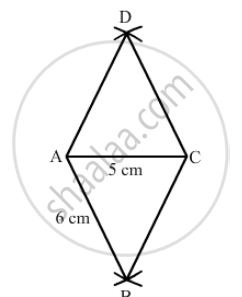Advertisements
Advertisements
प्रश्न
Draw a rhombus ABCD, if AB = 6 cm and AC = 5 cm.
उत्तर

1. Draw a line segment AC of 5 cm.
2. With A as centre, draw an arc of radius 6 cm on each side of AC.
3. With C as centre, draw an arc of radius 6 cm on each side of AC. These arcs intersect the arcs of step 2 at B and D.
4. Join AB, AD, CD and CB.
APPEARS IN
संबंधित प्रश्न
Name the quadrilaterals whose diagonals are perpendicular bisectors of each other
The following figure is parallelogram. Find the degree value of the unknown x, y, z.

All the angles of a quadrilateral are equal to each other. Find the measure of each. Is the quadrilateral a parallelogram? What special type of parallelogram is it?
Two adjacent sides of a parallelogram are 4 cm and 3 cm respectively. Find its perimeter.
Points E and F lie on diagonal AC of a parallelogram ABCD such that AE = CF. What type of quadrilateral is BFDE?
Which of the following statement is true for a rhombus?
Its diagonals bisect each other at right angles.
Fill in the blank, inthe following, so as to make the statement true:
A rhombus has all its sides of ...... length.
Diagonals of a rhombus are 20 cm and 21 cm respectively, then find the side of rhombus and its perimeter.
Lengths of diagonals of a rhombus ABCD are 16 cm and 12 cm. Find the side and perimeter of the rhombus.
Diagonals of a quadrilateral are perpendicular to each other. Is such a quadrilateral always a rhombus? Give a figure to justify your answer.
